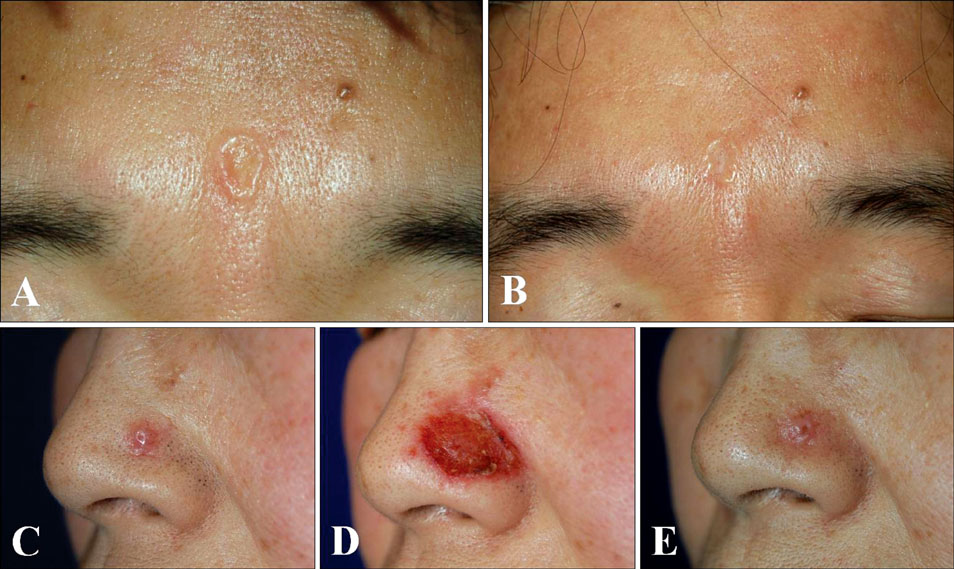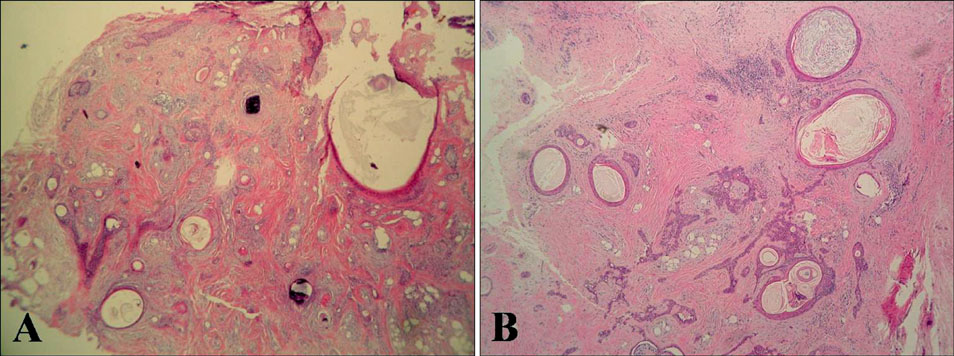Ann Dermatol.
2011 May;23(2):229-231. 10.5021/ad.2011.23.2.229.
Imiquimod as an Adjuvant Treatment Measure for Desmoplastic Trichoepithelioma
- Affiliations
-
- 1Department of Dermatology and Medical Research Institute, Yangsan Pusan National University Hospital, Yangsan, Korea. soesh97@hanmail.net
- 2Department of Dermatology, Pusan National University School of Medicine, Busan, Korea.
- 3Department of Orthopedics, Dong-A University Medical Center, Busan, Korea.
- KMID: 2156670
- DOI: http://doi.org/10.5021/ad.2011.23.2.229
Abstract
- Desmoplastic trichoepithelioma is a rare benign adnexal tumor. Although it is a benign lesion, patients often want to treat it due to cosmetic concerns when it occurs in an easily visible site. For our two cases, topical 5% imiquimod was an attractive treatment option as it is applied by the patients themselves and it has minimal side effects, including leaving no scar. However, the lesions recurred after clinical remission. To the best of our knowledge, this is the only report on utilizing imiquimod to treat a benign adnexal tumor, and especially desmoplastic trichoepithelioma.
Figure
Reference
-
1. Berman B, De Araujo T, Lebwohl T. Bolognia JL, Jorizzo JL, Rapini RP, editors. Immunomodulators. Dermatology. 2003. 1st ed. Philadelphia: Elsevier;2033–2053.2. Brownstein MH, Shapiro L. Desmoplastic trichoepithelioma. Cancer. 1977. 40:2979–2986.
Article3. Shaffelburg M, Miller R. Treatment of multiple trichoepithelioma with electrosurgery. Dermatol Surg. 1998. 24:1154–1156.
Article4. Sajben FP, Ross EV. The use of the 1.0 mm handpiece in high energy, pulsed CO2 laser destruction of facial adnexal tumors. Dermatol Surg. 1999. 25:41–44.
Article5. Bilu D, Sauder DN. Imiquimod: modes of action. Br J Dermatol. 2003. 149:Suppl. 66. 5–8.
Article6. Ito T, Amakawa R, Kaisho T, Hemmi H, Tajima K, Uehira K, et al. Interferon-alpha and interleukin-12 are induced differentially by Toll-like receptor 7 ligands in human blood dendritic cell subsets. J Exp Med. 2002. 195:1507–1512.
Article7. Jang BS, Jang HS, Park HJ, Kim MB, Oh CK, Kwon KS. Multiple scrotal epidermolytic acanthomas successfully treated with topical imiquimod. J Dermatol. 2007. 34:267–269.
Article8. Ahn SJ, Lee HJ, Chang SE, Lee MW, Choi JH, Moon KC, et al. Case of linear porokeratosis: successful treatment with topical 5% imiquimod cream. J Dermatol. 2007. 34:146–147.
Article9. Jo JH, Ko HC, Jang HS, Kim MB, Oh CK, Kwon KS. Infiltrative trichilemmal carcinoma treated with 5% imiquimod cream. Dermatol Surg. 2005. 31:973–976.
Article



